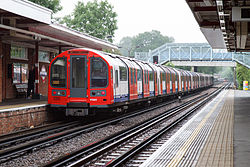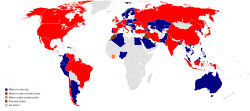


Rapid transit or mass rapid transit (MRT) or heavy rail,[2][3] commonly referred to as metro, is a type of high-capacity public transport that is generally built in urban areas. A grade separated rapid transit line below ground surface through a tunnel can be regionally called a subway, tube, metro or underground.[4][5][6][7] They are sometimes grade-separated on elevated railways, in which case some are referred to as el trains – short for "elevated" – or skytrains. Rapid transit systems are railways, usually electric, that unlike buses or trams operate on an exclusive right-of-way, which cannot be accessed by pedestrians or other vehicles.[8]
Modern services on rapid transit systems are provided on designated lines between stations typically using electric multiple units on railway tracks. Some systems use guided rubber tires, magnetic levitation (maglev), or monorail. The stations typically have high platforms, without steps inside the trains, requiring custom-made trains in order to minimize gaps between train and platform. They are typically integrated with other public transport and often operated by the same public transport authorities. Some rapid transit systems have at-grade intersections between a rapid transit line and a road or between two rapid transit lines.[9]
The world's first rapid transit system was the partially underground Metropolitan Railway which opened in 1863 using steam locomotives, and now forms part of the London Underground.[10] In 1868, New York opened the elevated West Side and Yonkers Patent Railway, initially a cable-hauled line using stationary steam engines.
As of 2021[update], China has the largest number of rapid transit systems in the world – 40 in number,[11] running on over 4,500 km (2,800 mi) of track – and was responsible for most of the world's rapid-transit expansion in the 2010s.[12][13][14] The world's longest single-operator rapid transit system by route length is the Shanghai Metro.[15][16] The world's largest single rapid transit service provider by number of stations (472 stations in total)[17] is the New York City Subway. The busiest rapid transit systems in the world by annual ridership are the Shanghai Metro, Tokyo subway system, Seoul Metro and the Moscow Metro.
- ^ "urbanrail.net > metro - subway - light rail". urbanrail.net.
- ^ "Mass transit - Urban Mobility, Efficiency, Environment". Britannica. 4 September 2024. Retrieved 29 September 2024.
- ^ "Fact Book Glossary". American Public Transportation Association. Retrieved 29 September 2024.
- ^ "Rapid transit". Merriam-Webster. Archived from the original on 2013-07-20. Retrieved 2013-07-31.
- ^ UITP (2011). "Recommended basic reference for developing a minimum set of standards for voluntary use in the field of urban rail, according to mandate M/486" (PDF). Archived from the original (PDF) on 2014-02-22. Retrieved 2014-02-16.
- ^ "Glossary of Transit Terminology" (PDF). American Public Transportation Association. Archived (PDF) from the original on 2013-05-12. Retrieved 2013-07-31.
- ^ Fouracre, Phil; Dunkerley, Christian; Gardner, Geoff (2003). "Mass rapid transit systems for cities in the developing world". Transport Reviews. 23 (3). Taylor & Francis Online: 299–310. doi:10.1080/0144164032000083095. S2CID 154931412. Retrieved 2 April 2023.
- ^ "Rapid Transit". Encyclopædia Britannica. Archived from the original on 2014-10-17. Retrieved 2014-11-28.
- ^ "Chicago". Archived from the original on 2015-04-16. Retrieved 2015-04-24.
- ^ Transport for London (1981). London Underground: History. Capital Transport. ISBN 978-0-904711-30-1. Archived from the original on 2013-01-16. Retrieved 2013-01-02.
- ^ "Luoyang and Ji'nan open metro lines". International Railway Journal. 2021-03-29. Retrieved 2021-06-07.
- ^ "China's Metro Boom Continues to Drive Rapid Transit Growth – Institute for Transportation and Development Policy". Institute for Transportation and Development Policy. 2018-07-30. Archived from the original on 2018-11-20. Retrieved 2018-11-20.
- ^ "Metro Data". metro-data.info. Archived from the original on 2018-09-29. Retrieved 2018-09-28.
- ^ "Rapid Transit Trends Show Record Growth in 2016, with Huge Increases in China, Brazil – Institute for Transportation and Development Policy". Institute for Transportation and Development Policy. 2017-02-17. Archived from the original on 2018-10-23. Retrieved 2018-11-20.
- ^ "Shanghai now the world's longest metro". Railway Gazette International. 4 May 2010. Archived from the original on 15 May 2010. Retrieved 2010-05-04.
- ^ Smith, Stephen J. (6 January 2014). "New Starts: Shanghai Metro World's Longest, Panama Canal Drama, Japan's Maglev". Next City. Archived from the original on 25 September 2014. Retrieved 2014-09-21.
- ^ "Facts – Subway and Bus Ridership". Metropolitan Transportation Authority (MTA). Archived from the original on 2014-09-12. Retrieved 2014-09-21.